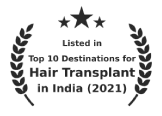
Management of Acne Scars – Facial and Truncal Acne Scars
Truncal Acne Scars, or acne vulgaris, is a common condition with a lifetime incidence of over 80%. Acne scarring is an unfortunate yet frequent sequela of acne. Any type of acneiform lesion, including comedones, papules, pustules, or nodulocystic lesions, may result in scarring.
Acneiform lesions that have been manipulated are more likely to result in scarring. Truncal acne scarring is more common in males than in females. Asian and black patients especially acne conglobata, have a higher risk of leading to scarring.
Several factors may predispose a patient to acne scarring. Prolonged angiogenesis is seen in lesions that proceed to scarring compared to lesions that resolve without scarring. An excess of metalloproteinases, such as collagenases, may also play a role in scar formation. One study showed that nonscarring patients developed peak inflammation 48 hours after an acneiform lesion had arisen. Patients with acne scars developed an inflammatory response later in the acne lesion’s evolution, and the inflammation was slower to resolve.
Patient History and Clinical Examination
Evaluation of a patient with truncal acne scarring requires consideration of several issues.
- 1. The age of the scars should be determined since scars continue to evolve over 12 months and some treatment modalities work best for newer scars.
- 2. The distribution of the scars should be noted as certain.
- 3. Acne scar morphology.
- 4. Previous use of isotretinoin.
Facial acne scars have been classified into three primary morphologic types: icepick, boxcar, and rolling scars. While these scar morphologies can also be seen on the trunk, acne scars on the chest and back are usually either i) hypertrophic /Keloidal or ii) atrophic
Some therapies may be directed to both types of scarring, while other therapies are specific to either hypertrophic / Keloidal scars or atrophic scars.

Therapeutic Considerations and Application
The best treatment for truncal acne scars is prevention. Patients who delay starting anti-acne medication for at least 3 years from acne onset have a greater degree of scarring than those who start acne treatment earlier. Isotretinoin therapy is the only proven cure for acne in the course of severe acne to prevent scarring.

Excision
If scarring does occur, either type of acne scars of the trunk may be treated by surgical excision. Given the high tension of truncal skin, patients should be warned of the high likelihood that the surgical scar might expand or become hypertrophic resulting in a sub-optimal cosmetic outcome. Surgical excision should be contemplated on the trunk only when the surgeon thinks that the replacement scar will be preferable to the original scar.

Pulsed Dye Laser
Both atrophic and hypertrophic/Keloidal scars may have a red color, especially early in their evolution, due to microvasculature in the scar. The use of the 585 nm pulsed dye laser to lessen scar erythema was first recognized in 1993. Several studies thereafter have confirmed these results and also demonstrated that increasing benefits can be seen with multiple treatments.

Ablative Lasers
The use of ablative lasers for improving acne scarring on the trunk is limited. Ablative systems that are helpful in improving acne scars on the face are not suitable for use on the chest and back. However, new fractional ablative technologies, such as Active FX, and Fraxel re: pair(10,600 nm CO2) are being used by some to treat truncal acne scarring without prolonged healing.

Semi-ablative Lasers
Nonablative systems, such as the fractionated 1,550 nm erbium-doped fiber laser can be safely used off the face. The Fraxel laser induces collagenases underneath atrophic scars. Multiple treatments are needed to treat atrophic scars, and patients are counseled that about 50% improvements in scars can be seen after several treatments.

Nonablative Lasers
Other nonablative lasers in the infrared range, such as 1,320 nm also can help to improve atrophic scars. These lasers work by causing thermal injury in the dermis while sparring the epidermis with cooling. The infrared lasers are absorbed by dermal water, and the scattering of thermal energy damages dermal collagen and incites an inflammatory response that activates fibroblasts and stimulates collagen remodeling. Multiple treatments are needed to elevate facial atrophic scars with these laser treatments. These devices have minimal efficacy for acne scars on the trunk.

Intralesional Corticosteroids
Individual hypertrophic and Keloidal scars may be treated with intralesional corticosteroids to soften and shrink scars as well as to decrease associated pruritus require multiple treatments.
Certifications & Partnerships









The Saraswat Hospital Credentials

17000 +
Happy Clients

20 +
Years of Experience
98%
Hair Growth Rate

1500 +
Cases of Grade 5/6

4.9
Google Ratings
EXCELLENTTrustindex verifies that the original source of the review is Google. Very happy with my decision to choose Saraswat hospital. Great staff and excellent aftercare.Posted onTrustindex verifies that the original source of the review is Google. Excellent treatment with good results and entire staff treated very friendly nature. I am 100% satisfied.Posted onTrustindex verifies that the original source of the review is Google. Taking PRP session here, got great results and good professional treatment..Posted onTrustindex verifies that the original source of the review is Google. Very professional service and great results.Posted onTrustindex verifies that the original source of the review is Google. Excellent experince overall. Minimal pain, quick recovery and my hairline looks fantastic.Posted onTrustindex verifies that the original source of the review is Google. Amazing results. My hair feels healthier, thicker and stronger after the treatment thank you Dr Saraswat Sir.Posted onTrustindex verifies that the original source of the review is Google. Dr Saraswat is truly gifted. Our baby's cleft lup surgery turned out beautiful. And we are so thankful for the care and kindness we received.Posted onTrustindex verifies that the original source of the review is Google. Outstanding care from dr and team. The surgery was a success and our child's smile say it all. Highly recommend.Verified by TrustindexTrustindex verified badge is the Universal Symbol of Trust. Only the greatest companies can get the verified badge who has a review score above 4.5, based on customer reviews over the past 12 months. Read more

